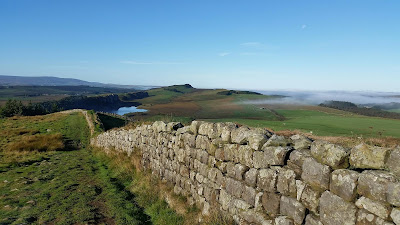From Bowness-on-Solway on the west coast as far east as the fort known to the Romans as Banna, but now known under the name Birdoswald, Hadrian's Wall was a turf wall, with stone used only to build the turrets, due to a local shortage of limestone for mortar. This means very little of the Wall has survived. But from Birdoswald - only a few kilometres from Banks, where I spent the night at Quarryside B&B - eastwards, the Wall is made of stone and much more of it is still visible.
It is punctuated at regular intervals by turrets, two per Roman mile (1.48 km), plus signal towers and forts.
I walked along the Wall to Birdoswald with two ladies from London who had been staying at the same bed & breakfast. They had no high-tech hiking gear, only leggings and running shoes, and their backpacks were too small so they carried the excess in shopping bags... it would have driven me crazy to walk like that, but my new companions seemed perfectly happy to go trooping over the moors looking for all the world as if they were out on a Saturday shopping trip!
 |
| Birdoswald Fort |
On either side of Birdoswald is a still-standing section of wall running about a kilometre and a half long, making this the longest continuous section of wall still in place.
Not long after Birdoswald Fort the trail drops down into the valley to cross the Irthing River via the Millennium Bridge, currently undergoing repair (which made for some excitement, crossing the river on the wooden planks the workmen have laid to fill in for the mussing bit). Further east, where the river flowed in Roman times, the abutments of a Roman bridge, rebuilt three times between AD 122 and 207, may still be seen.
At Gilsland, I left Cumbria behind and entered Northumberland - where my trip began almost a month ago!
Coming out of the village, the path lies in the Vallum, the defensive ditch dug behind the Wall, which is at present underground here, with a "modern" dry stone wall built on top of it and the mound formed by the rubble from digging the ditch visible on the other side.
This led to Thirlwall Castle, the name of which means "hole in the wall" castle. The hole was probably made, or at least made bigger, when the castle was built - out of recycled stone from the Roman Wall!
It was by now getting quite blustery, so I joined two ladies taking shelter from the wind within the castle walls for a picnic lunch.
 |
| Lunch at the castle |
More fields, more sheep and cows, and then the path came to Walltown Quarry, now a national park, and the landscape changed dramatically as the Whin Sill came into view!
This is the start of the toughest part of the trail, the Crags. The path rises and falls, rises and falls, over a succession of rocky outcrops. I tackled a series of these under an increasingly gloomy sky.
I passed among cattle grazing in the Roman fort of Aesica.
It grew misty and wet, and I began to wish I were out of the Crags and safely in my room at the hostel, when suddenly the clouds lifted and the sun came out over the Crags! My spirits lifted and I enjoyed covering the last few kilometres up and down to the hostel at The Sill with spectacular views!
 |
| Winshields Crag - the highest point on the trail |
Banks - The Sill 25 km + (patchy GPS signal)










































































